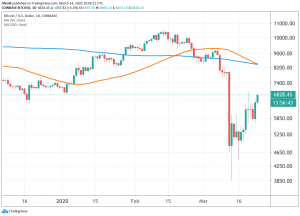Is Bitcoin Becoming an Alternative For Wall Street Investors?
Following the last few weeks carnage in the financial markets, bitcoin (BTC) may be starting to look like a viable alternative for some of the capital that is leaving Wall Street.

A “decoupling” of bitcoin prices from the broader financial system is something many community members have called for, and said that they expect will happen in the near future. Not surprisingly, such a shift would also likely attract more capital from the traditional financial system and over to bitcoin, simply due to the benefit of having an uncorrelated asset in a portfolio. However, the jury is still out on whether BTC is an uncorrelated asset.
And given what we have seen in the markets over the past few days, we may have started to see evidence of this shift happening, with bitcoin now seemingly decoupling from the stock market and other risk assets. Unlike the broader financial markets, the number one digital asset has so far only seen one day of heavy selling as a result of the coronavirus market panic and has already recovered nearly two-thirds of the sell-off.
Interestingly, bitcoin’s rebound has so far been markedly more powerful than that of ethereum (ETH) and other major altcoins such as XRP and litecoin (LTC), which has essentially remained in a consolidation pattern since the sell-off.

Not surprisingly, the bitcoin rebound has also led to a rise in the bitcoin dominance, defined as bitcoin’s share of the overall market capitalization of all cryptocurrencies, which is now up by around 5 percentage points since its bottom in mid-February. As of press time on Tuesday, the dominance number stood at 67.5%.

In practice, it can, therefore, be argued that bitcoin has acted similarly to gold, which also saw an initial sell-off as market participants panicked and sold “everything” in a global run to the U.S. dollar. Following the initial decline, however, gold also rebounded and has now recovered more than half of its losses.

On the other hand, the stock market, represented by the broad S&P 500 index, is currently down about 30% from the peak before the crisis. And although stocks were pointing sharply higher today after a slew of new stimulus measures were announced by the Fed yesterday, a sustained trend change has yet to happen.





